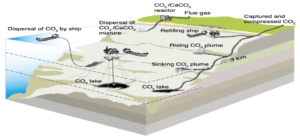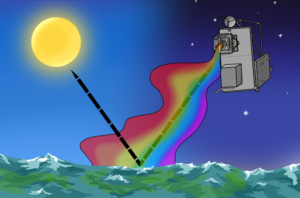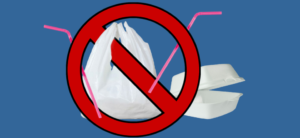There are hundreds of thousands of tons of plastic in the ocean, much of which exists as tiny particles. These microplastics are spread throughout the ocean which makes them excruciatingly difficult to access, find, and remove. For these reasons most ocean plastic clean-up ideas target macroplastics at singular locations which are easy to reach, such as in ports or around estuaries. Such approaches ignore microplastic in the ocean far from the coasts however. The international fleet of cargo ships criss-cross the world’s oceans and process billions of tons of seawater for ballast each year, could these vessels filter out microplastics from the open ocean?
One of the challenges with removing tiny bits of plastic from the ocean is simply getting to them in the first place; the ocean is a big place after all. The few ocean clean-up systems that exist tend to focus on fixed areas that are known to have high concentrations of microplastics, like near ports or river estuaries. The Ocean Cleanup Project is a notable exception which is intended to be deployed in ocean gyres where marine debris naturally accumulates, but this system targets macroplastics and has not performed as hoped, not to mention that it needs a dedicated vessel to periodically visit it to remove the collected debris. What if there were a way to remove microplastic from larger swathes of the ocean without a vessel making a special trip? Perhaps cargo ships could be part of the solution.
Seawater Ballast
At present there are approximately 55,000 cargo vessels that constantly criss-cross the world’s ocean. These ships occasionally hit bad weather with big waves which causes a ship to rock from side-to-side, also known as rolling. Rolling can be dangerous for the ship and crew, and not to mention uncomfortable, so captains like to minimize it when possible. To reduce rolling the most common solution is to place heavy weight low in the ship to reduce it’s center of gravity and make it more stable. This weight is called ballast.
In days of old ballast was anything heavy: rocks, bricks, iron ore, or anchor chain for example. But moving this weight on and off the ship at each turn of cargo in port was quite literally back-breaking work. Around the end of the 19th century, vessels began using seawater instead. Seawater is plentiful, dense, and unlike chain or ore, it fills all available space in a ballast hold making better utilization of the space. It’s no wonder that it’s been the ballast of choice ever since.
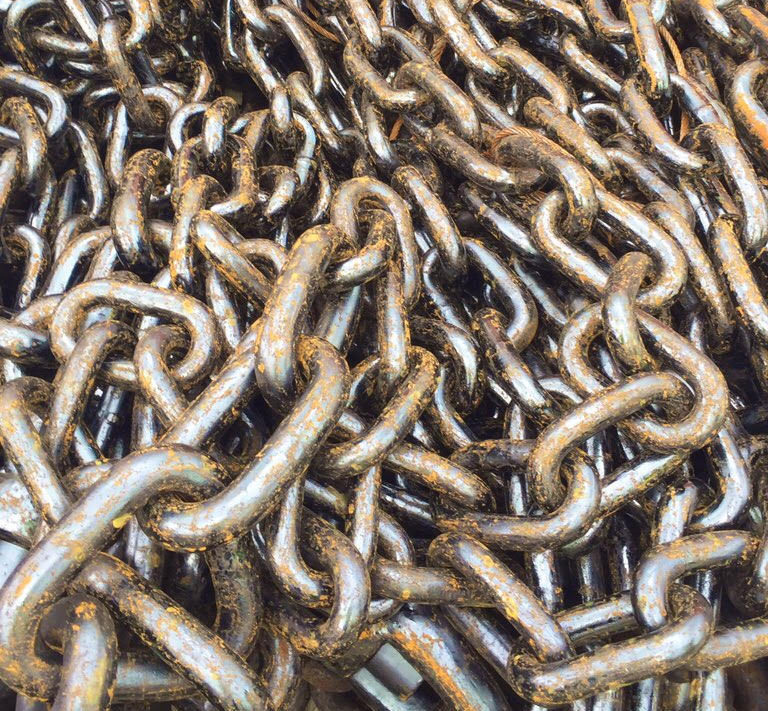
The amount of ballast carried by a ship depends on the ship’s size, its route, and numerous other factors, but could range from a few cubic meters (a cubic meter is roughly equal in weight to a ton) to over 200,000 cubic meters per vessel [1]. When a ship takes on ballast, thousands of cubic meters of seawater are pumped aboard the ship into specialized tanks where it sits for days to weeks at a time while the water’s collective mass does all the work of stabilizing the ship. Once the ballast is no longer needed, the seawater is pumped back into the ocean.
Microplastic in Ballast Water
Seawater may look empty to the naked eye, but in reality it is filled with thousands of tiny particles and microorganisms. Over time, we’ve come to learn that ballast water can serve as an inadvertent highway for marine organisms, allowing them to cross oceans into new environments where they can become invasive species and disrupt ecosystems. Check out zebra mussels in the Chesapeake Bay as an example. To combat this transport of invasive species, many vessels are starting to incorporate ballast water treatment systems that cleanse the seawater before it is discharged from the vessel.

But invasive species aren’t the only dangers to ecosystems lurking in ballast water; microplastics are becoming increasingly more prevalent as well. Just like invasive species, microplastics can disrupt ecosystems in many dangerous ways. Could the micro plastic be filtered out? Ships are already filtering and treating ballast water for invasive species, so it’s not far-fetched to imagine a system that works at an industrial scale. But would it make a difference in the ocean plastic crisis? Let’s see if the numbers work out.
How much microplastic in ballast water?
Let’s assume that all of the 55,000 ocean-going vessels of the world carry seawater ballast. I’ll split the world fleet into small vessels and large vessels, representing 70 percent and 30 percent of the total respectively, to capture the difference in size between vessels that do international voyages versus domestic ones. I’ll assume that large vessels carry 200,000 cubic meters of seawater ballast and small vessels carry 50,000.
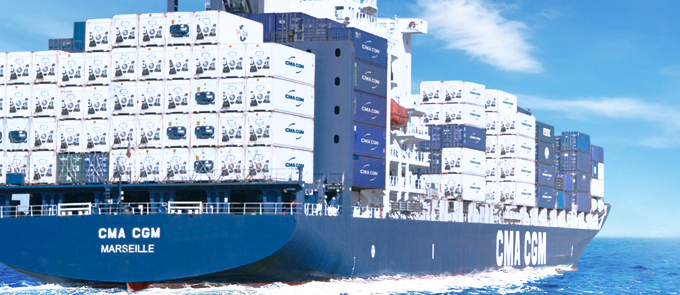
I’m going to further assume that small vessels make two dozen voyages (round-trip journeys) a year while large vessels make half as many, the logic being that small vessels do shorter trips while larger vessels make longer trips. Let’s assume that each vessel makes one complete exchange of ballast water each voyage. Under these assumptions the global ocean-going fleet processes 85.8 billion cubic meters of seawater each year.
No one knows exactly how much plastic is in the ocean today and estimates vary widely. Moreover, there isn’t a standard method of assessing microplastic concentrations: particle size, weight, and even location in the water column varies across the research literature. One researcher estimates the amount of microplastics within the ocean to be within the range of 15 to 51 trillion particles, weighing between 93 and 236 thousand metric tons [8], let’s work with this.
Generally speaking, plastic concentrations in the ocean are inversely proportional to distance from shore and proportional to depth. For this back of the envelope assessment, I’ll use an estimated ten particles per cubic meter which is conservative for some concentration areas like the Great Pacific Garbage Patch and coastal zones, but maybe on the upper end for other areas [2][10].
Cargo ships as microplastic vacuums
Using the concentration of ten particles per cubic meter, this means that vessels process 481 billion particles of microplastics each year. Now let’s assume that there is a system that removes 50 percent (to account for efficiency losses) of the microplastics contained in a given volume of seawater. That means our removal rate equates to roughly 429 billion plastic particles per year for the fleet, or approximately 2,145 tons [8]. This is equivalent to roughly 24 percent of the estimated number of plastic particles within the Great Pacific Garbage Patch [5].
Unfortunately, while we’re removing plastics, the world continues to pollute at an estimated rate of eight million metric tons of plastic debris flowing into the ocean each year [9]. According to researchers, roughly one percent of this is microplastics, or 80,000 tons. This means that our current pollution rate is more than thirty times our removal rate using cargo ships.
Reality check
These back of the envelope calculations make some broad assumptions and miss all sorts of dynamics: such as macroplastics disintegrating into microplastics over time and changing concentrations; changes in pollution rate; or changes in the number of vessels, as examples. Perhaps the largest assumption is that we can effectively remove microplastic from ballast water in the first place. I’m also ignoring other systems on a ship that continuously circulate seawater throughout the ship, primarily for cooling, that could improve the microplastic collection rate per ship potentially.
Even with this basic model, it makes clear the fact that 55,000 commercial vessels processing close to a billion tons of seawater ballast each year would not even come close to cleaning-up the ocean given our current pollution rate. However, if we were to stop polluting, the impact could be significant. In fact, if we were to stop dumping waste into the ocean entirely, the global fleet could reduce the amount of microplastic in the ocean by half within one to two decades.
The microplastics in the ocean aren’t going anywhere, and unless we come-up with ways to remove them, they’ll be wreaking havoc on marine ecosystems for decades to come. Perhaps cargo ships could be part of the solution in the ocean plastic problem in the years to come.
[1] “BALLAST WATER AND SHIPS.” National Research Council. 1996. Stemming the Tide: Controlling Introductions of Nonindigenous Species by Ships’ Ballast Water. Washington, DC: The National Academies Press. doi: 10.17226/5294. https://www.nap.edu/read/5294/chapter/4#23
[2] Choy, C.A., Robison, B.H., Gagne, T.O. et al. The vertical distribution and biological transport of marine microplastics across the epipelagic and mesopelagic water column. Sci Rep 9, 7843 (2019). https://doi.org/10.1038/s41598-019-44117-2 https://www.nature.com/articles/s41598-019-44117-2#citeas
[3] Maes Thomas, Van der Meulen Myra D., et. al. Microplastics Baseline Surveys at the Water Surface and in Sediments of the North-East Atlantic. Frontiers in Marine Science. Vol 4. (2017) https://www.frontiersin.org/articles/10.3389/fmars.2017.00135/full
[4] Hansen, Lisa. Macro and micro plastics in an urbanized and non-urbanized fjord estuary in the Northeast Pacific Ocean. University of Washington. Señor Thesis. (2016) https://digital.lib.washington.edu/researchworks/handle/1773/36335
[5] Lebreton, L., Slat, B., Ferrari, F. et al. Evidence that the Great Pacific Garbage Patch is rapidly accumulating plastic. Sci Rep 8, 4666 (2018). https://www.nature.com/articles/s41598-018-22939-w#citeas
[6] Riviera. Ballast Water Treatment System Market Size. Accessed April 2020. https://www.rivieramm.com/opinion/opinion/the-size-of-the-ballast-water-treatment-technology-market-54770
[7] Environmental Protection Agency. Ballast Water Self Monitoring (2011) https://www3.epa.gov/npdes/pubs/vgp_ballast_water.pdf
[8] Erik van Sebille et al 2015 Environ. Res. Lett. 10 124006. https://iopscience.iop.org/article/10.1088/1748-9326/10/12/124006;jsessionid=123F0E078E457FC6106D3ACEE956F209.c3.iopscience.cld.iop.org
[9] National Ocean Service. A Guide to Plastic in the Ocean (2019). Accessed April 2020. https://oceanservice.noaa.gov/hazards/marinedebris/plastics-in-the-ocean.html
[10] Outi Setälä,Kerstin Magnusson,Maiju Lehtiniemi,Fredrik Norén. Distribution and abundance of surface water microlitter in the Baltic Sea: A comparison of two sampling methods. Marine Pollution Bulletin. Elsevier (2016). https://www.sciencedirect.com/science/article/abs/pii/S0025326X16304696

